Chassahowitzka River and Springs
The Chassahowitzka River is located in the city of Homosassa on Florida’s central gulf coast. It’s located in Citrus County.
Chassahowitzka River Video Tour
History of Chassahowitzka River and Springs
Like many springs in Florida, Chassahowitzka Springs has a fascinating history. It has attracted humans for tens of thousands of years.
There are several notable archeological sites in the area, including the nearby Crystal River Archeological State Park
According to the FWC, the name Chassahowitzka is a Seminole Native American name, which means “Pumpkin hanging place”.
This name may refer to a type of pumpkin plant which is now uncommon, or possibly extinct.
Archeologists have discovered many ancient artifacts from the Chassahowitzka River area.
Artifact discoveries include shell mounds, bone fish hooks, 8,000 year old arrowheads and various other tools and objects from more recent periods.
The Chassahowitzka River area was reportedly used for liquor smuggling during the prohibition area. Al Capone is rumored to have owned property on the river.
Some historical documents refer to the Chassahowitzka Main Spring as “Devil’s Punch Bowl”.
The Chassahowitzka National Wildlife Refuge was created in 1943.
Visiting Chassahowitzka Springs
The best time to visit Chassahowitzka Springs depends on your desired activities.
For those who are able, the best time to visit is when school is in session, because crowds will be lower.
Summer and warm weather are best for swimming and snorkeling because the air temperature is warmer.
Warm-weather months are often worse for mosquitoes and biting insects. Some narrow areas of the river have partial shade, and others are fully exposed to the sun.
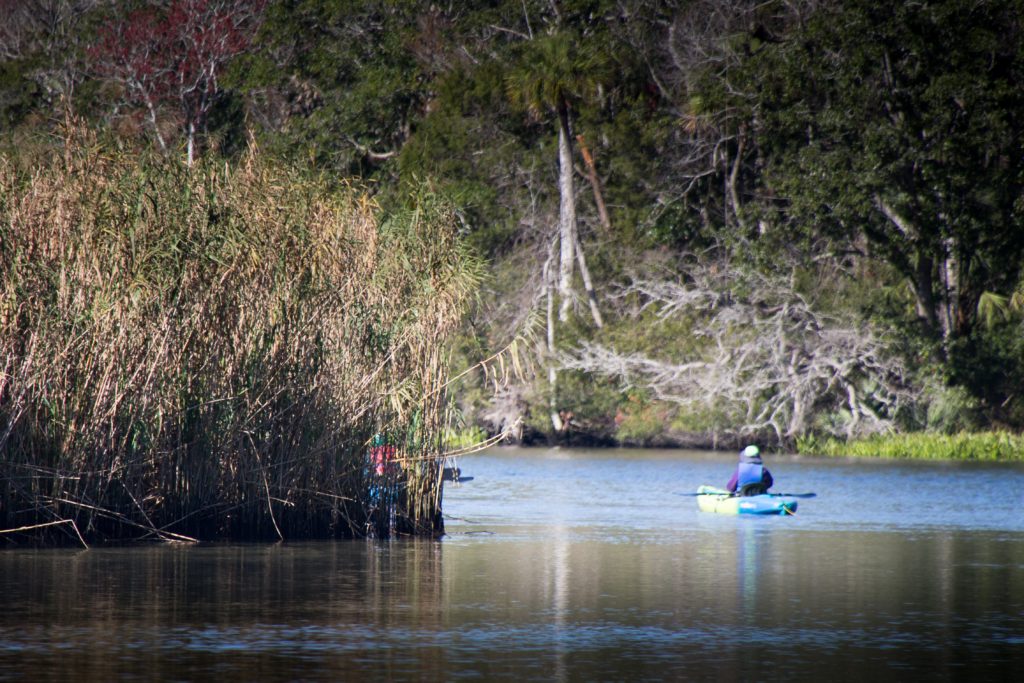
For those who want to see manatees, the cold winter months are best.
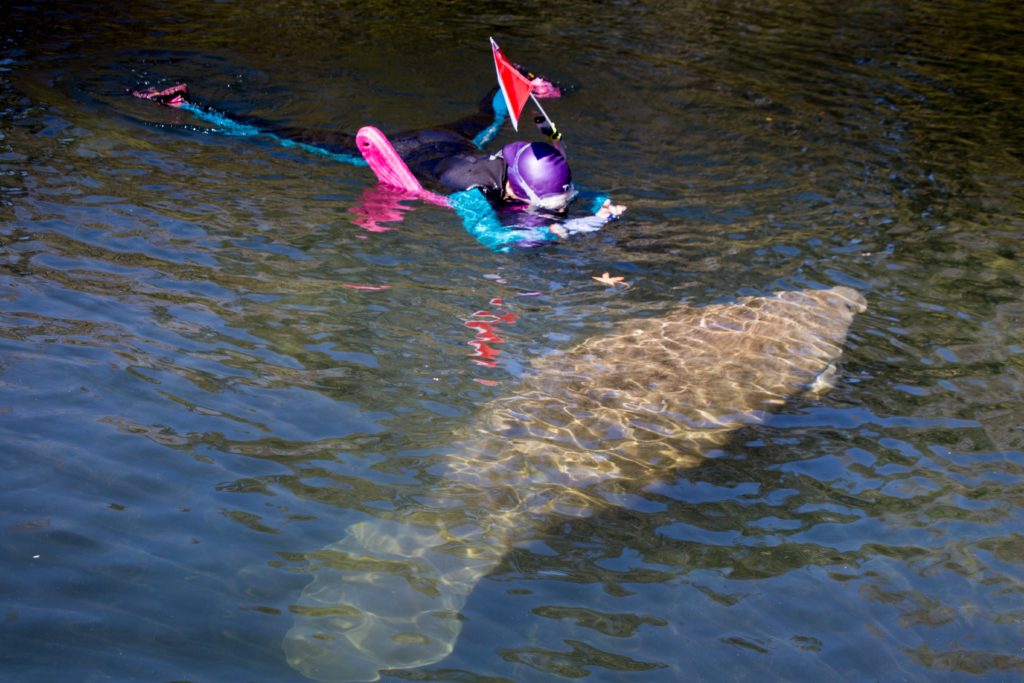
The river is generally less crowded in the winter, but can still become crowded on weekends and holidays.
Location
The Chassahowitzka River is conveniently located near both Orlando and Tampa. Both cities are approximately 60-90 minutes away by car.
This region has multiple toll roads. Visitors should be aware that alternative, non-toll roads may also exist for those who wish to avoid tolls.
| Distance (Miles) | Estimated Travel Time | |
|---|---|---|
| Chassahowitzka River to Orlando | 88.7 miles | 1 hr 38 min |
| Chassahowitzka River to Tampa | 69.1 miles | 1 hr 12 min |
| Chassahowitzka River to Crystal River | 14.8 miles | 26 min |
The community around the Chassahowitzka River is small and rural. It used to be even smaller, but has grown and become more developed in recent years.
Today there are many residential housing developments in the area. Some residential communities are newly built, and others are left over from previous building sprees, often the product of inflated housing markets, bubbles and manias.
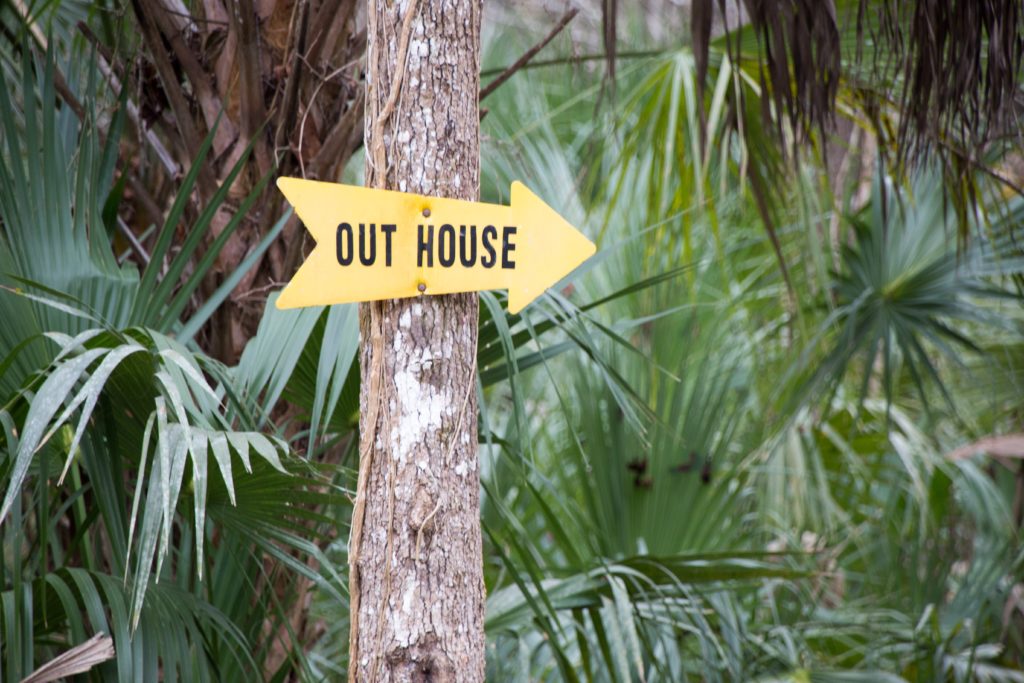
Many neighborhoods have old, failing septic tanks which leak sewage and nutrient pollution into the aquifer, springs and Chassahowitzka River.
Chassahowitzka River
The Chassahowitzka River system is also informally known as “The Chaz”.
The Chassahowitzka River is fed by numerous springs along the river. The water travels to the west for approximately 5.6 miles.
The Chassahowitzka River eventually empties into Chassahowitzka Bay, and then into the Gulf of Mexico. The entire river is tidally influenced. Tides can have a large impact on the river’s water level, clarity and flow rate.
Approximately five springs flow into the upper part of the river. Many more springs flow into the lower portion.
The Chassahowitzka River is recognized as an Outstanding Florida Waterway. Part of the river enters the Chassahowitzka National Wildlife Refuge.
In general, the Chassahowitzka River feels undeveloped and natural. The natural river bank areas consist of marsh and low coastal hardwood hammock.
Approximately three miles of the lower Chassahowitzka River are protected, and are part of the Chassahowitzka National Wildlife Refuge. The lower part of the river is mostly brackish tidal creeks.
The upper part of the Chassahowitzka River is mostly small tributary creeks. It is less natural than the lower part.
Houses have been built directly on the river banks in many places. Some wetland areas have been destroyed and dredged to create lawns and artificial canals for real estate developers.
Some cabins are built as stilt houses, and sit directly over the water. Many stilt houses on the river, especially in the lower river, have been destroyed by hurricanes are in disrepair.
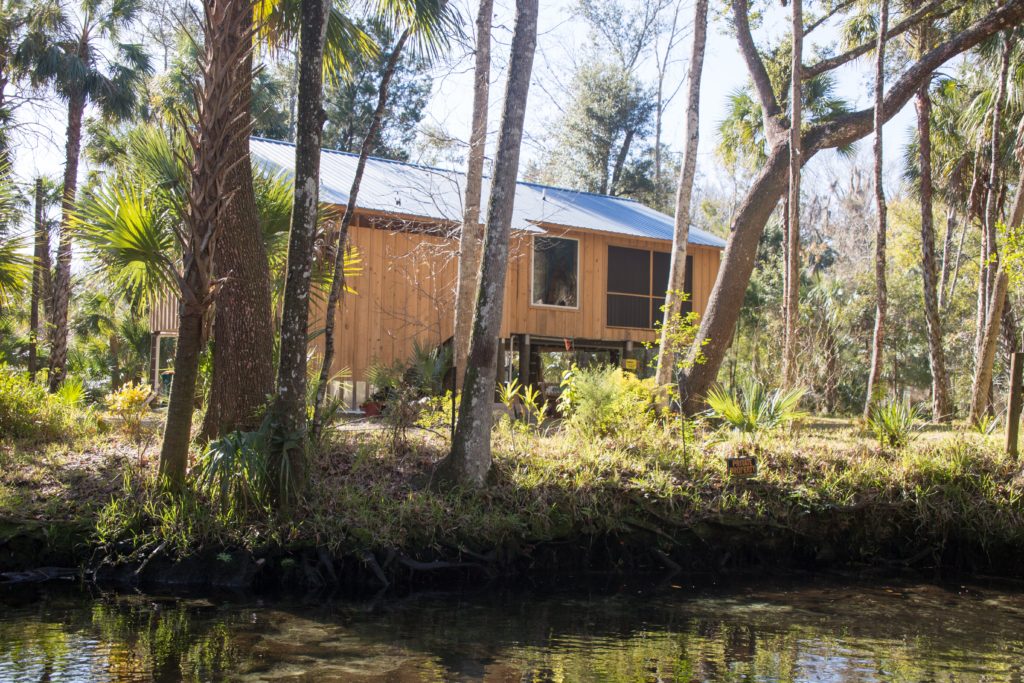
Some parts of the Chassahowitzka River are narrow and shaded, and other parts are broad, without protection from the sun or wind. Paddling up river can be challenging depending on the tide and wind conditions.
Most of the Chassahowitzka River is less than four feet deep; the entire river is very shallow.
The water clarity in the Chassahowitzka River is generally clear, but it depends on local rainfall conditions and the tide.
It is generally most clear at low tide, and becomes less clear during rising tide and at high tide. It can also become less clear after periods of heavy rainfall.
The water is generally most clear above the spring vents, and is less clear in deeper areas of the river.
Wildlife
There are alligators in the Chassahowitzka River, and many other forms of native Florida wildlife.
The Chassahowitzka River National Wildlife Refuge area is excellent for bird watching. It was created in 1943 to help protect threatened birds and wildlife.
Many other types and varieties of native Florida animals and wildlife live in and around the Chassahowitzka River.
Manatees rely on the springs in Chassahowitzka for survival, as discussed further in this guide.
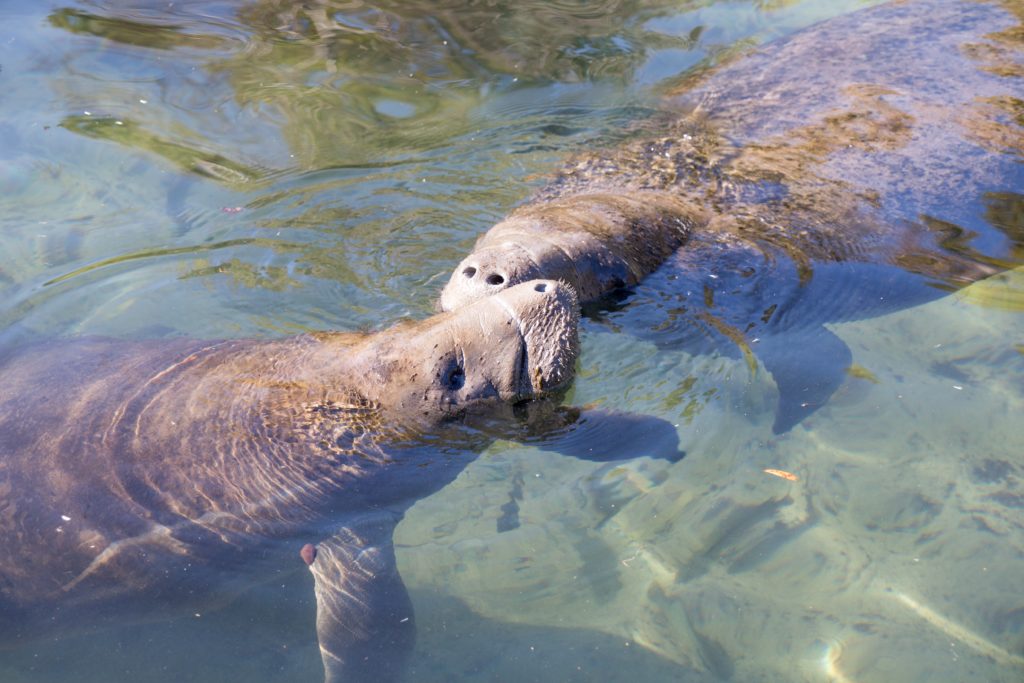
The area is also excellent for fishing. Although the number and variety of fish is reduced compared to the past, it is still better than many areas.
Many believe that the river’s shallow depth helps reduce the number of boats and river damage.
On the other hand, the river’s shallow depth makes it more vulnerable to damage by boats.
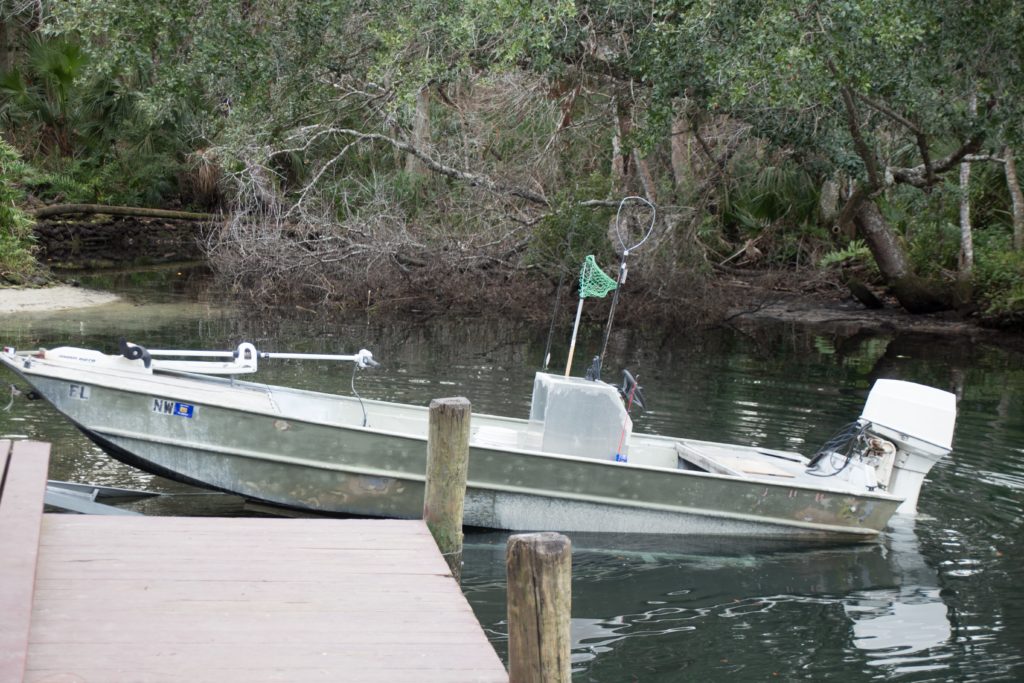
Damage to the river bottom, shoreline erosion caused by propellers, boat wakes, water pollution and other human impacts have a large effect on the natural environment.
Manatees are also negatively affected by motorboats, and are often cut, injured and killed by boat propellers.
Chassahowitzka Springs Water Temperature
The water temperature in Chassahowitzka River remains relatively stable year-round because it is spring-fed. The spring water which feeds the Chassahowitzka River remains a constant 72 degrees year-round.
In the summer it is cooler than non-spring fed water, and it is warmer in the winter.
The warm water is a vital cold-weather refuge for a large population of manatees.
Chassahowitzka River Facilities
There is a small general store near the boat ramp.
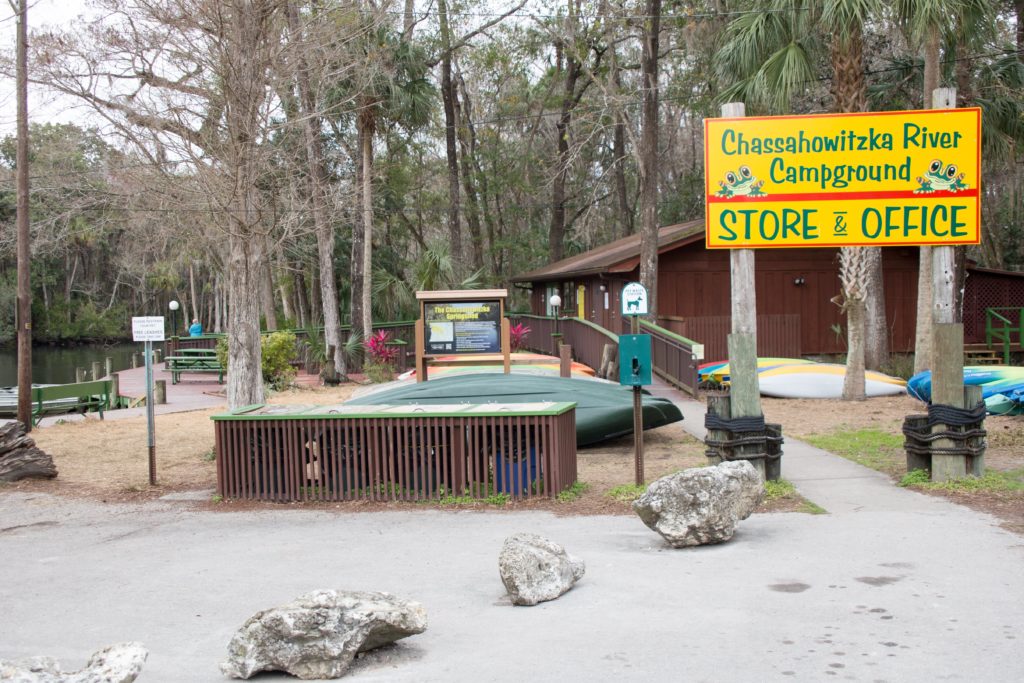
The general store handles boat rentals and campground check-ins. There are small indoor restrooms with flushing toilets.
There is a Publix grocery store near the Chassahowitzka River Campground and a Walmart is approximately 5 miles away. There is a modest variety of restaurants in the area.
Parking
There is a small cost to park at the Chassahowitzka River boat ramp.
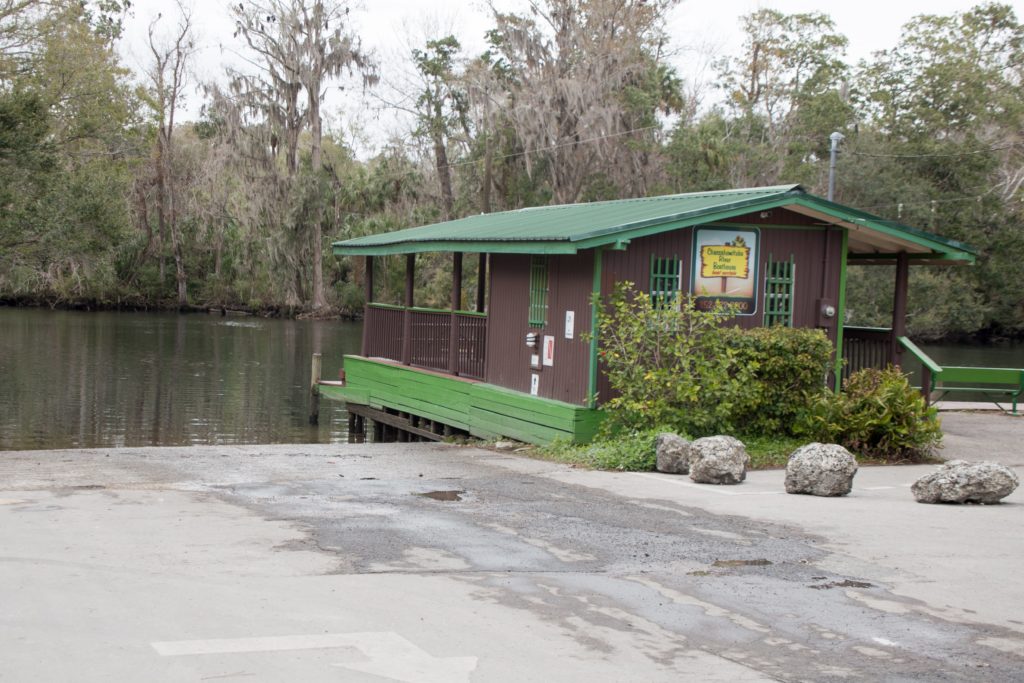
There is a small office on-site which accepts credit cards.
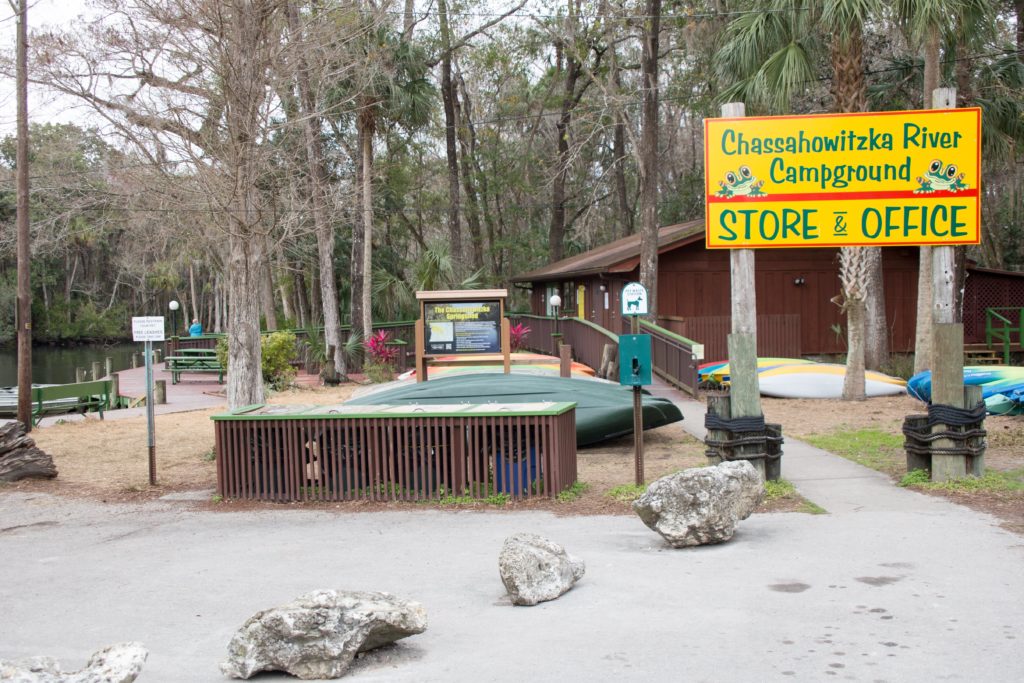
The boat ramp parking lot often fills quickly during popular visitation times, especially in the summer.
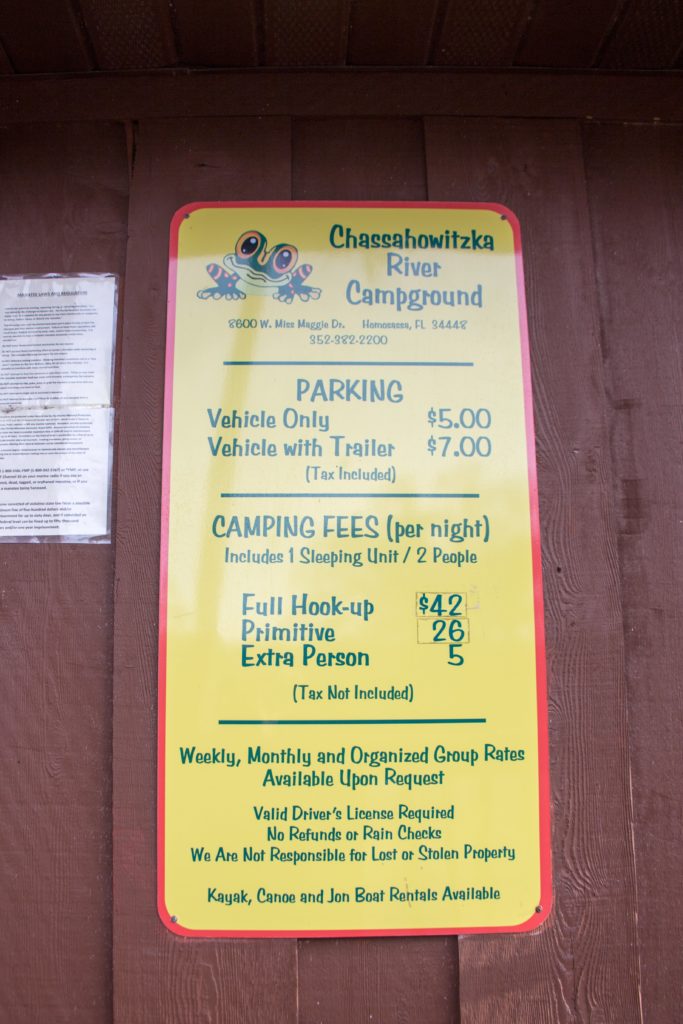
Things to Do
The Chassahowitzka River Campground offers boat rentals, including canoes, kayaks, SUP paddleboards and jon boats.
Fishing and birdwatching are excellent on the Chassahowitzka River. The location is especially popular among wildlife photographers.
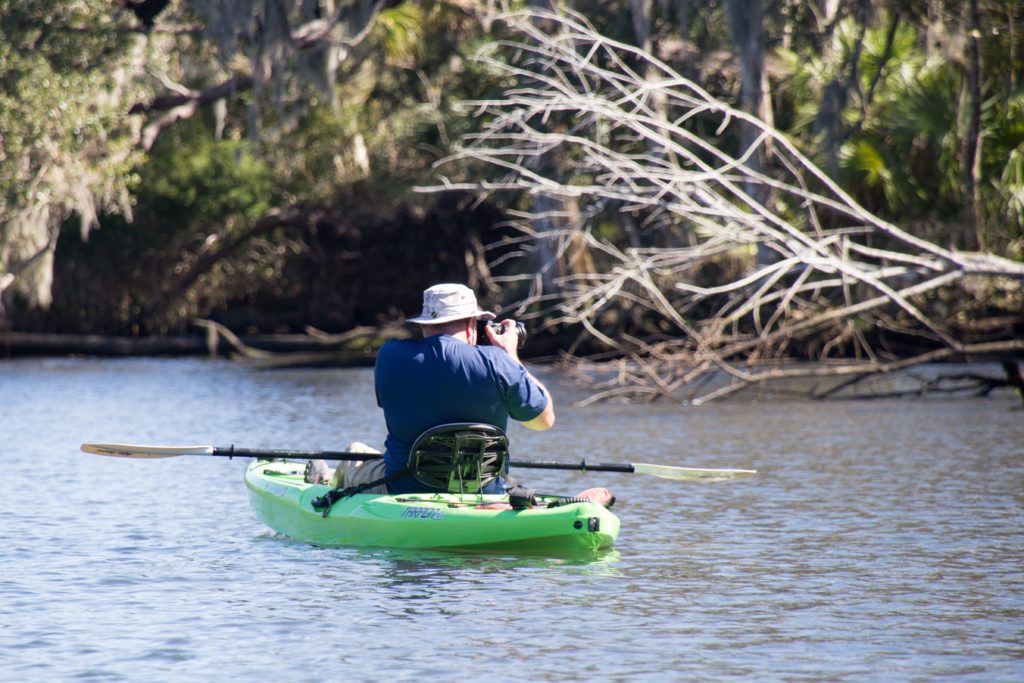
Swimming with Manatees
Because it is spring-fed, the water temperature in Chassahowitzka River remains relatively consistent year-round.
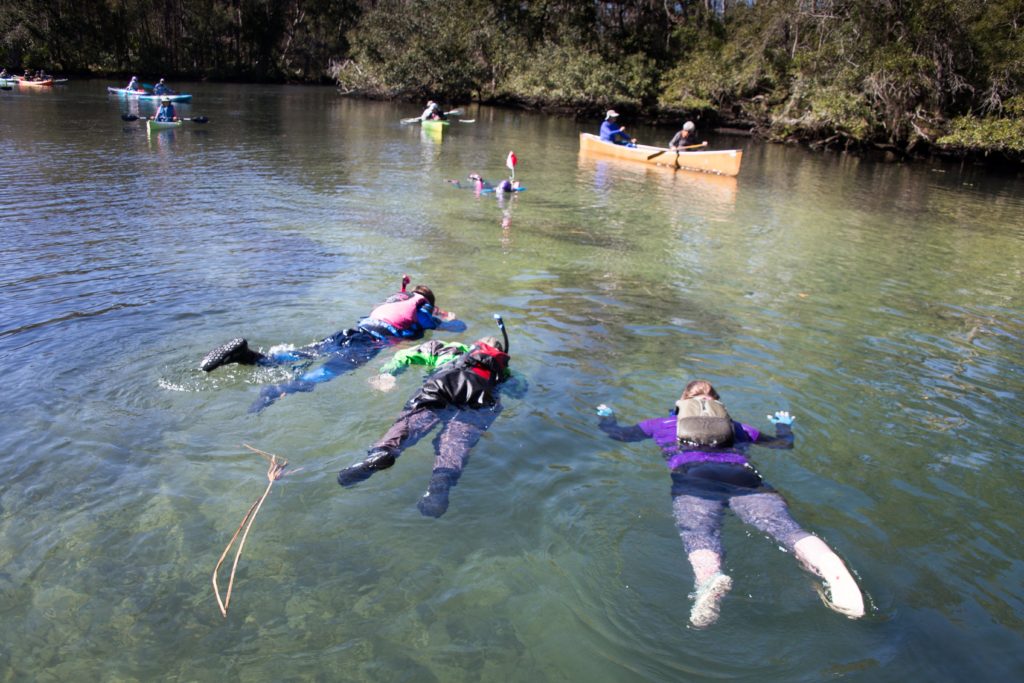
In the summer it is cooler than non-spring fed water, and it is warmer in the winter.
The spring water which feeds the Chassahowitzka River remains a constant 72 degrees year-round.
The Chassahowitzka River is warmer than the Gulf of Mexico during the winter. The warm water provides an important warm-water refuge for Florida manatees.
Without safe access to warm water, manatees will be injured or killed, as they are exposed to a condition known as “Cold Stress Syndrome” (CSS).
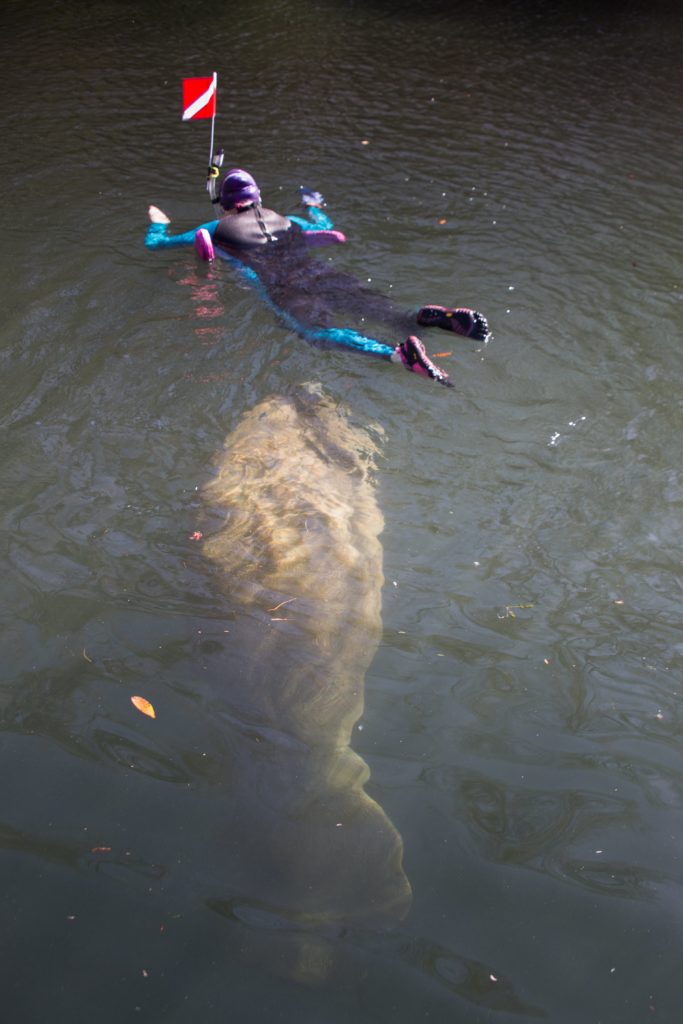
Visitors should be careful not to disturb manatees in any way. It’s dangerous for the manatees, and it’s very illegal. The fines are enormous, and it’s considered a serious crime.
If manatees are disturbed they may leave the warm water, and may not return if they are scared by human activity.
Manatees have a limited number of warm-water refuges. If they are driven away, they may not have any alternatives. If exposed to cold water, manatees are likely to suffer severe injury or death.
Swimming
You can swim in parts of the Chassahowitzka River, but not others. Some areas, like Seven Sisters Spring, The Crack, and others offer excellent swimming.
Visitors should consult with knowledgeable authorities before swimming in unknown areas, or taking unknown risks.
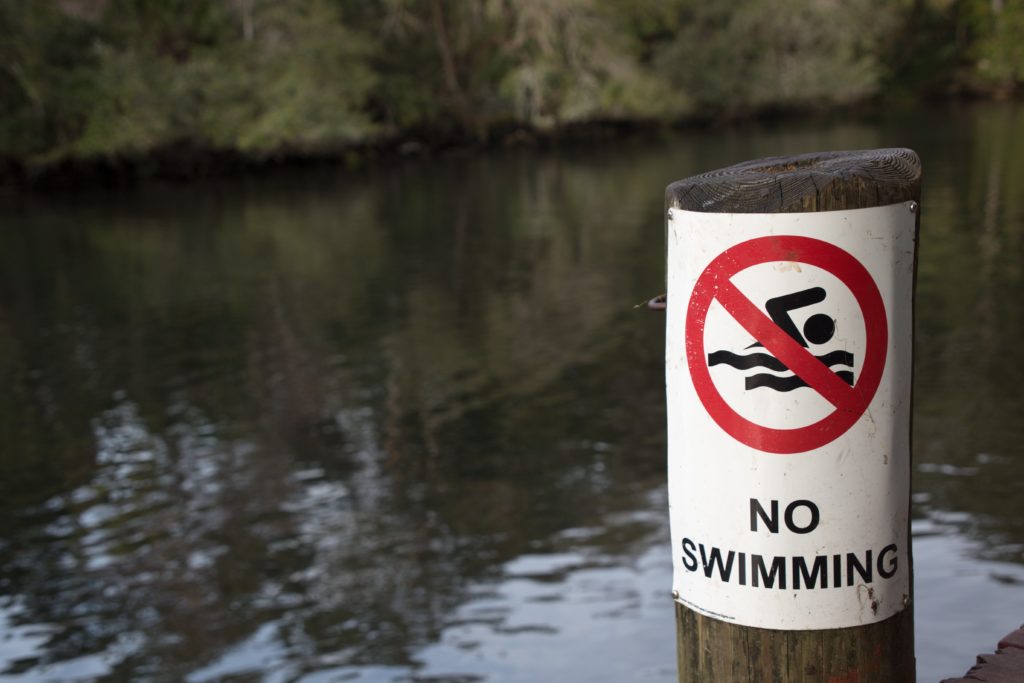
Visitors should always remain aware of their surroundings and take appropriate precautions according to their own skill level, and that of their party.
Some areas in the Chassahowitzka River are not recommended for swimming because of the danger of boat traffic.
Alligators and Bull Sharks
The Chassahowitzka River and its springs are natural waterways, with all of the hazards that come with natural settings.
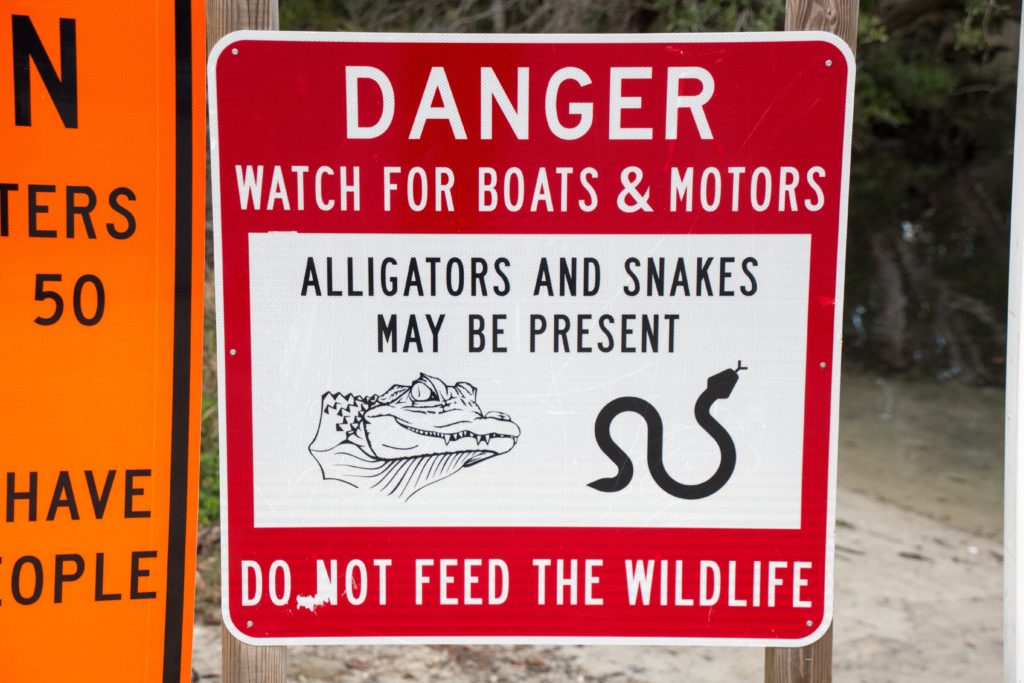
Snakes, Alligators and other potentially dangerous wildlife inhabit the Chassahowitzka River and spring areas.
Bull sharks can swim into estuaries and freshwater. Their presence has been documented in the Chassahowitzka River as recently as 2018.
Alligators in the Chassahowitzka River have attacked humans while swimming. These archived news reports from Bay News 9 and the Citrus County Chronicle document one attack on a swimmer in the river.
Kayaking, Canoeing and Paddle Boarding
The Chassahowitzka River is one of the best kayaking spots in Florida. It’s Considered good for both beginners and experienced paddlers.
Novices enjoy the relatively easy paddling conditions, and expert paddlers say they never tire of the natural beauty, wildlife, and pristine nature.
Novice paddlers should be aware of their abilities and surroundings, and take appropriate precautions.
Visitors who own their own boats can launch at the boat ramp. There is a fee for parking, but launching is free.
Visitors who do not own their own kayaks or paddle craft can rent from the on-site concessionaire. Kayaks, canoes and jon boats are all available for rent.
The river current is usually low to moderate. Paddlers should check local tide information.
Paddling against wind and current may be difficult for some, and it may take additional time. Be sure to allow enough time and energy to return safely.
Paddling down stream can be considerably easier than paddling back up stream, especially if it is against the wind and tide.
All visitors should remain aware of their surroundings and watch for boat traffic, alligators and other hazards.
Chassahowitzka Springs
There are many dozens of springs in the Chassahowitzka River. Some are among the most beautiful springs in Florida, and others are not very attractive or inviting.
The most well-known and popular are located upriver, in the eastern section of Chassahowitzka River. There are numerous springs downriver, as well.
The most popular springs include:
- Seven Sisters Spring
- The Crack
- Chassahowitzka Main Spring
Other springs in the Chassahowitzka River include:
- Crab Creek Springs
- Ruth Spring
- Blue Spring
Visitors should be exceptionally careful in all of the springs near Chassahowitzka River.
Tragically, numerous drownings in Seven Sisters Springs. There is an “offshoot” section of the cave in which people enter, become lost, disoriented, and drown. Over the years several drownings have occurred in the same location.
Swimming in overhead environments like the Seven Sisters Spring caves can be exceptionally dangerous.
Rocks and surfaces around the Seven Sisters Spring are usually very hard, slippery and sharp.
There may be other possible hazards in the water as well, such as broken glass, fish hooks, and others. People have been attacked by wildlife in the Chassahowitzka River, including alligators.
Swimmers should take care not to let their paddles, feet or fins trample or disturb the fragile river bottom. It reduces water clarity and harms the river’s health in many ways.
Chassahowitzka Main Springs
Chassahowitzka Springs’ Main Spring is located approximately 350 feet northeast of the boat ramp. It sits in the middle of the river and spring run. There is usually a spring boil which is more visible at low tide.
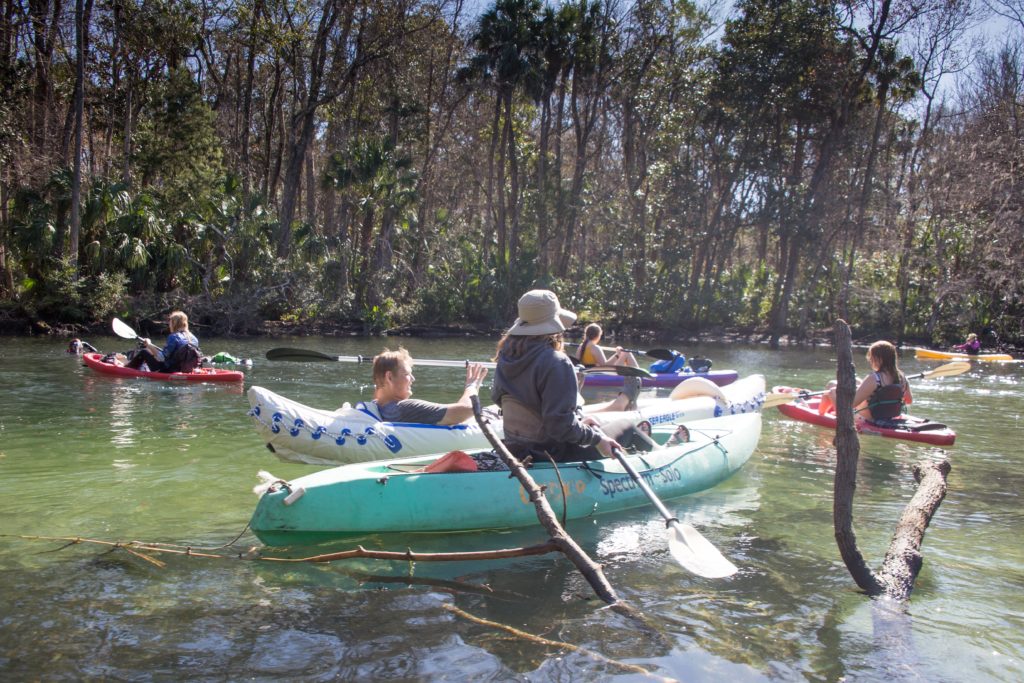
The water is usually approximately 13 feet, and the water is clear/green. Due to the water depth and lack of visibility, this spring vent is not visible, and is not a popular attraction. This section is popular for viewing manatees though, who gather near the main spring for warmth.
This spring vent lies in the boat channel with boat traffic, so visitors should exercise responsible and wise safety precautions.
Seven Sisters Springs
The Seven Sisters Springs are a series of springs in the Chassahowitzka River.
The spring vents are located in a small, shallow tributary stream and spring run. The water is exceptionally clear. The river bottom is sand and limestone, which is sharp and slippery. There may be algae, depending on current conditions.
Seven Sisters Spring is easy to access, but it’s only accessible from the water. The springs are located a short paddle up stream from the boat ramp. To get there:
- After leaving the boat ramp area, travel upriver for a short distance.
- Turn into a small, shallow channel area and spring run.
There are two groups of spring vents at Seven Sisters Spring.
One group is closer to the main river, and another series is found at the back of the spring run.
The Seven Sisters Springs are generally only accessible by kayak, canoe or paddle board.
The spring run is too shallow for most motorized vessels to access. Responsible boaters should not try, as motorboats and deep-draft vessels damage the fragile river bottom.
The Seven Sisters Spring holes are very round holes, called solution holes. They were formed over many centuries as high-speed spring water flows eroded holes in the soft and porous limestone.
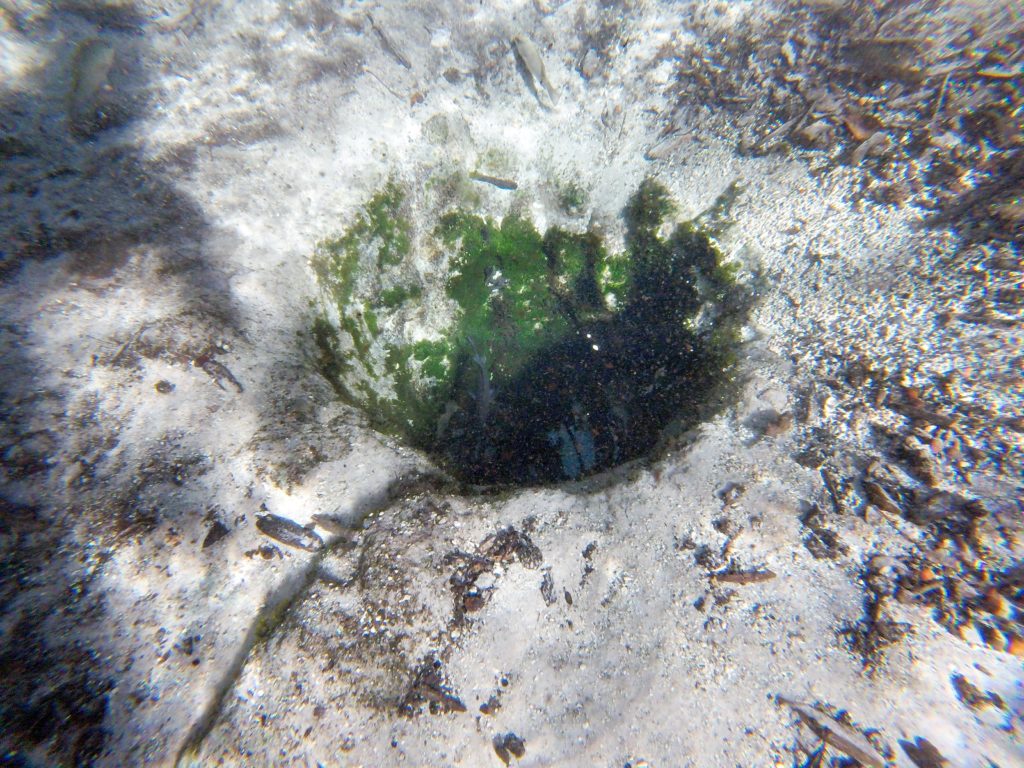
The springs are beautiful, especially when viewed from underwater.
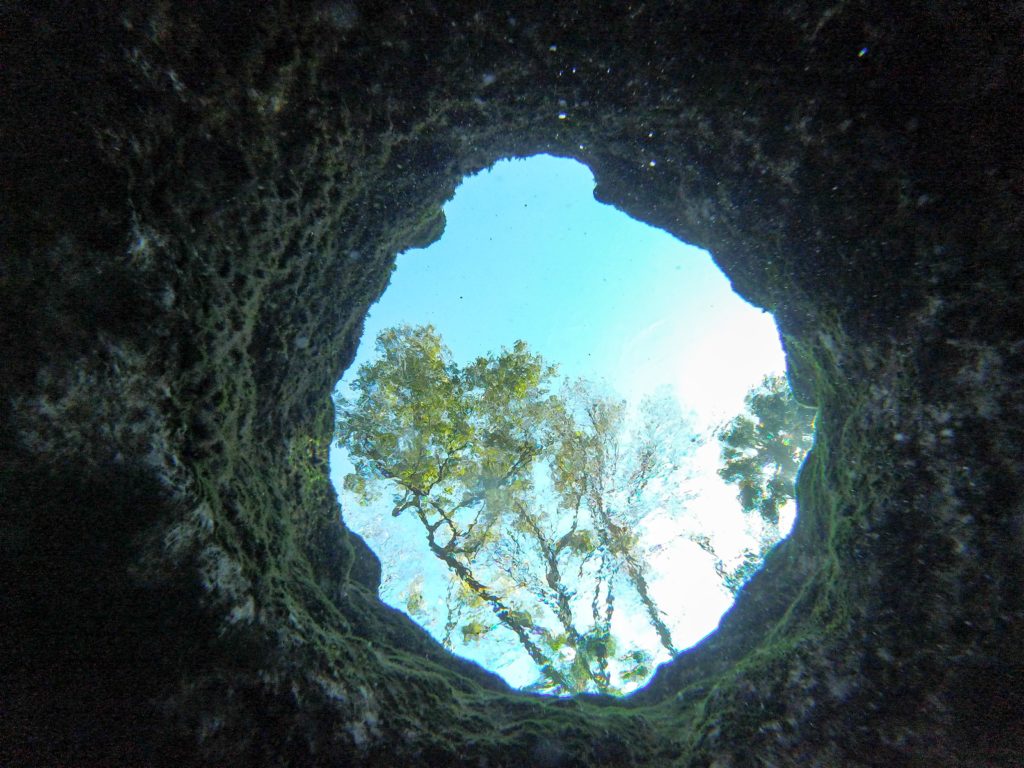
The water glows with a brilliant blue, and the water is extremely clear. Fish are usually found inside the tunnels, and air pockets on the tunnel ceiling give an exotic effect.
Seven Sisters Spring is a very popular and fun place to visit. But, visitors should be careful. There are many hazards in the spring, and injuries are common.
The limestone rock surrounding the Seven Sisters springs is extremely slippery. Visitors should consider wearing protective footwear with good traction. Be extremely careful not to fall on the rocks.
Depending on the weather, mosquitoes, biting flies, noseeums and other insects may be a severe problem. There are snakes in the area.
Underwater Cave Tunnels
Seven Sisters Spring is famous for its underwater cave tunnels. Many visitors enjoy swimming inside the caves, through the rocky tunnel, to surface at the next hole.
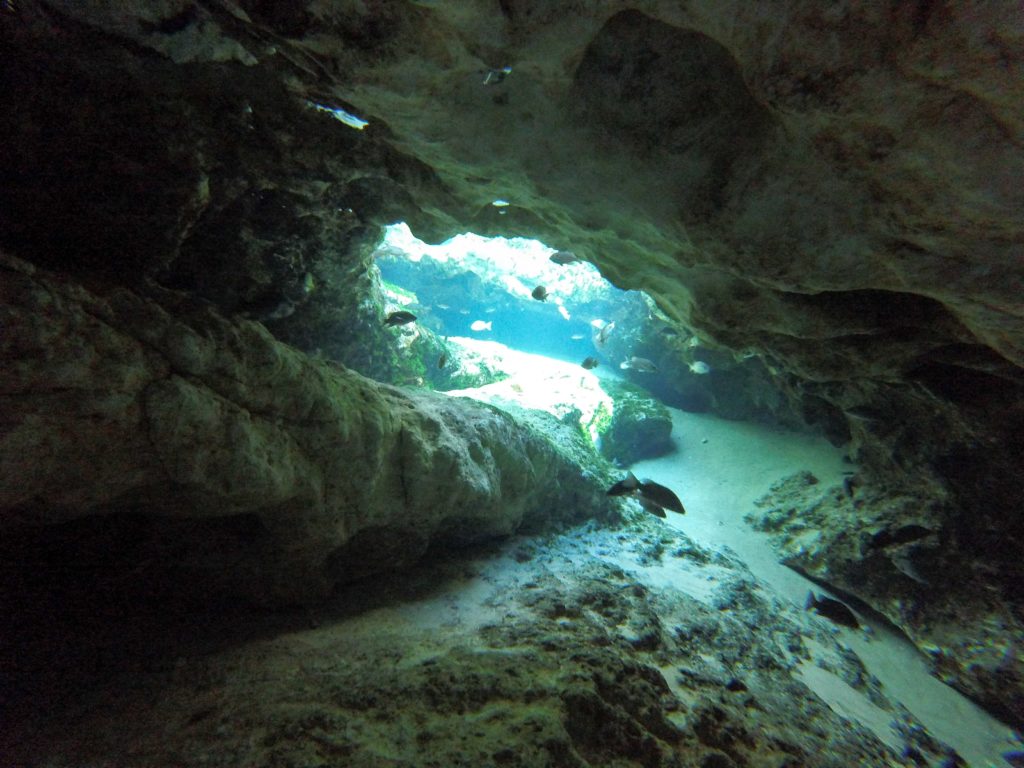
The swim-through tunnels can be extremely dangerous. Several people have died while swimming through them over the years.
Anyone who decides to swim through the tunnels should be aware of the risks, and choose according to their own training, skill level and abilities.
Swimming in overhead environments is always dangerous. It is not recommended, except by properly trained professionals with appropriate precautions, skill and experience.
- Many visitors panic inside the tunnels
- The limestone rock can be very sharp and may scrape or cut skin
- There is a high risk and danger of hitting your head on the overhead rock
- Depending on current conditions, there can be high water flow through the tunnels,
- Swimming in confined overhead environments always carries extreme risk and danger
The authors of this website strongly advise that visitors take all appropriate safety precautions and do not subject themselves to dangerous risks.
Crab Creek Springs
The entrance to Crab Creek is located 250 feet down river from the boat ramp and launch area, and then up a short spring run of approximately 100 feet.
The land surrounding Crab Creek is privately owned and there are large houses built upon the land.
There are several spring vents in the spring basin. Depending on the tide level and spring water flow, there are usually spring boils present on the water surface. The basin is approximately 6-10 feet deep.
The water is often a cloudy blue, and there is often algae and vegetation in the spring. It is not known to be clear, and is not recommended for swimming.
Even though it is not recommended for swimming, it is still a nice spring and is worth stopping if you are curious and have the time.
The Crack
The Crack is one of the most beautiful springs in the Chassahowitzka River. It is a long vent which sort of has the shape of a lightning bolt. It is approximately 35 feet long.
Its width varies, but is generally about 2-10 feet wide.
The Crack is surrounded by a spring basin and swimming hole. The spring basin is medium-sized. It feels large when you’re there alone, but can feel small if there are others in the pool.
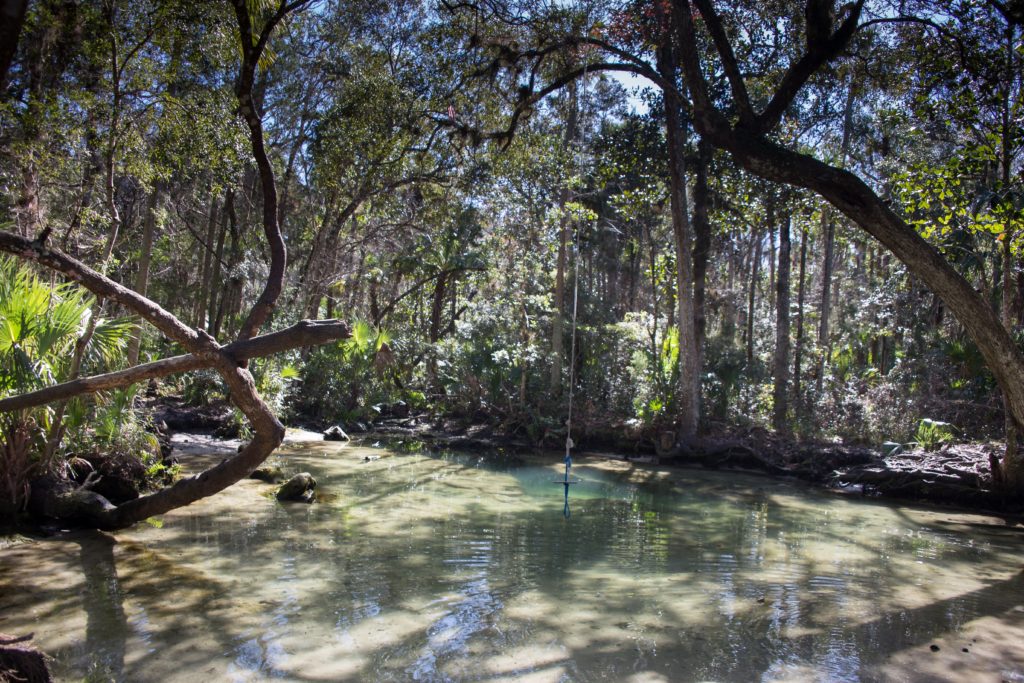
The depth of the spring basin varies depending on water level, but it is approximately 10-15 feet deep.
The water clarity at the Crack is generally beautiful, clear and blue.
First time visitors should be careful and aware of their surroundings.
There are snakes and alligators in the area. Many locals advise making noise continuously so that any alligators or snakes will have a chance to avoid you, and to avoid surprising wildlife.
Be particularly careful during periods of high alligator activity, like during mating season.
Other wildlife like snakes and river otters may also present dangers to humans, among other things. Take appropriate safety precautions.
Try your best to avoid stepping on the sandy/silty bottom.
Many, many people visit The Crack and the Chassahowitzka River. If everyone tramples the bottom it will damage the spring and river. If the bottom is disturbed the water clarity will be diminished, and the river health will suffer.
How to Find The Crack
Some reports suggest that it can be accessed via land, but most people access it from the water, via paddling up Baird Creek.
Via the Chassahowitzka river, the total distance to The Crack is approximately 1 mile from the Chassahowitzka River boat launch.
Depending on your paddling speed, it typically takes about 30-60 minutes in each direction to access The Crack.
There are not any restrooms or facilities of any kind on the Chassahowitzka river, or at the Crack.
The Crack is accessed via a ½ mile tributary named Baird Creek. The entrance for Baird Creek is approximately 1/2 mile downriver of the boat ramp.
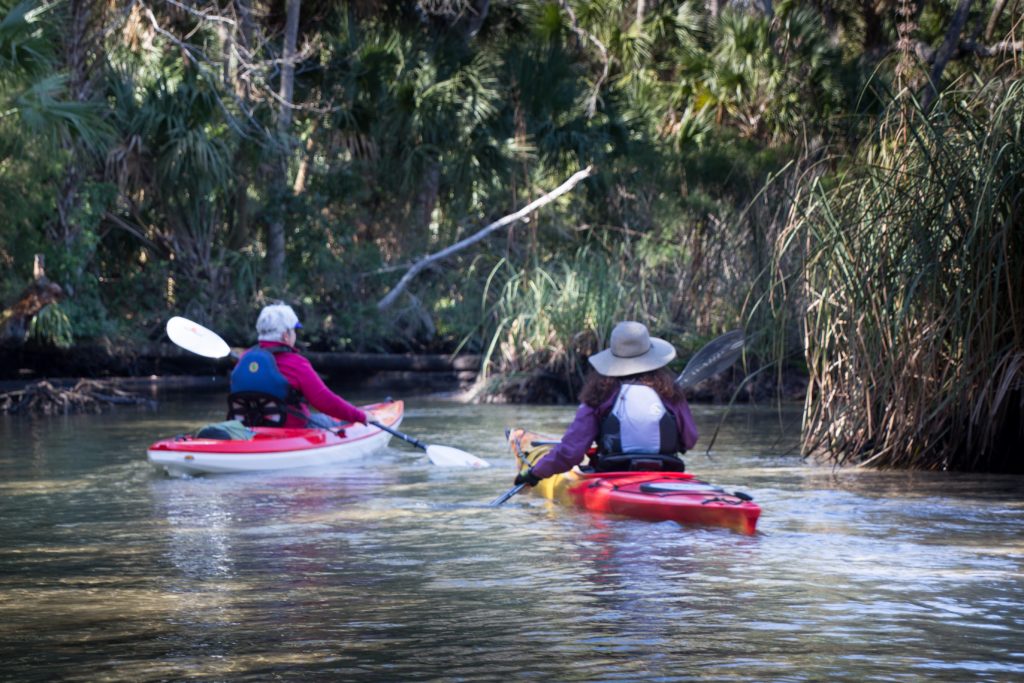
The Chassahowitzka River flows from east to west. Baird Creek is on the south side.
Said another way: when traveling down-river toward, away from the Chassahowitzka boat ramp and towards the Gulf of Mexico, Baird Creek is on the left hand side of the river.
At the end of Baird Creek there is a long, shallow spring run which flows from the Crack spring vent.
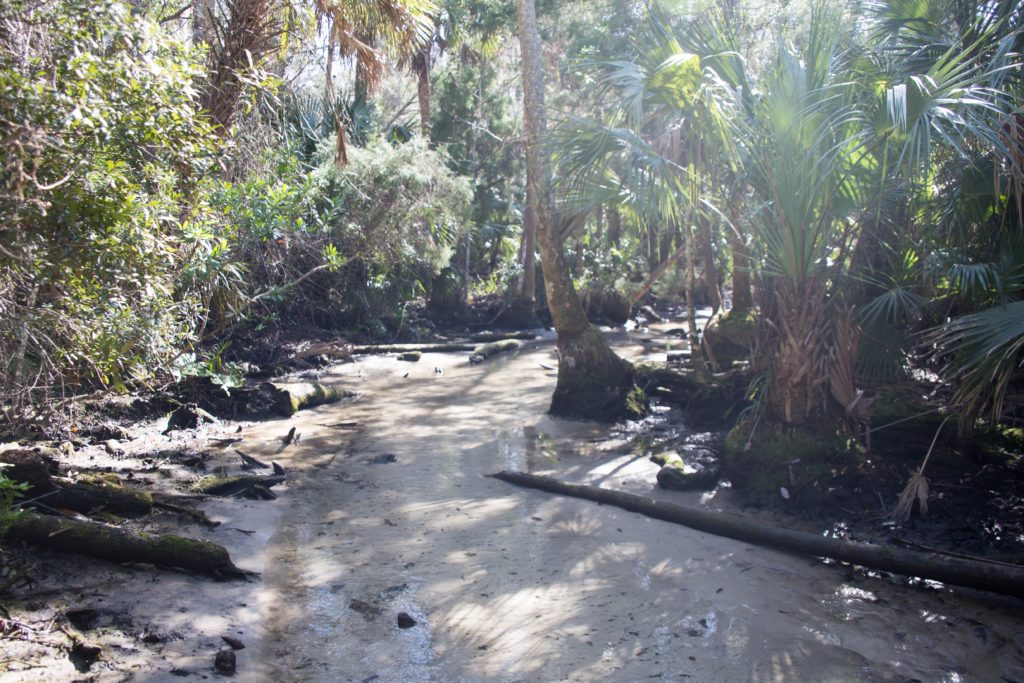
The final spring run is too shallow for canoes or kayaks, so they are typically left at the end of the spring run, or are sometimes walked up the spring run.
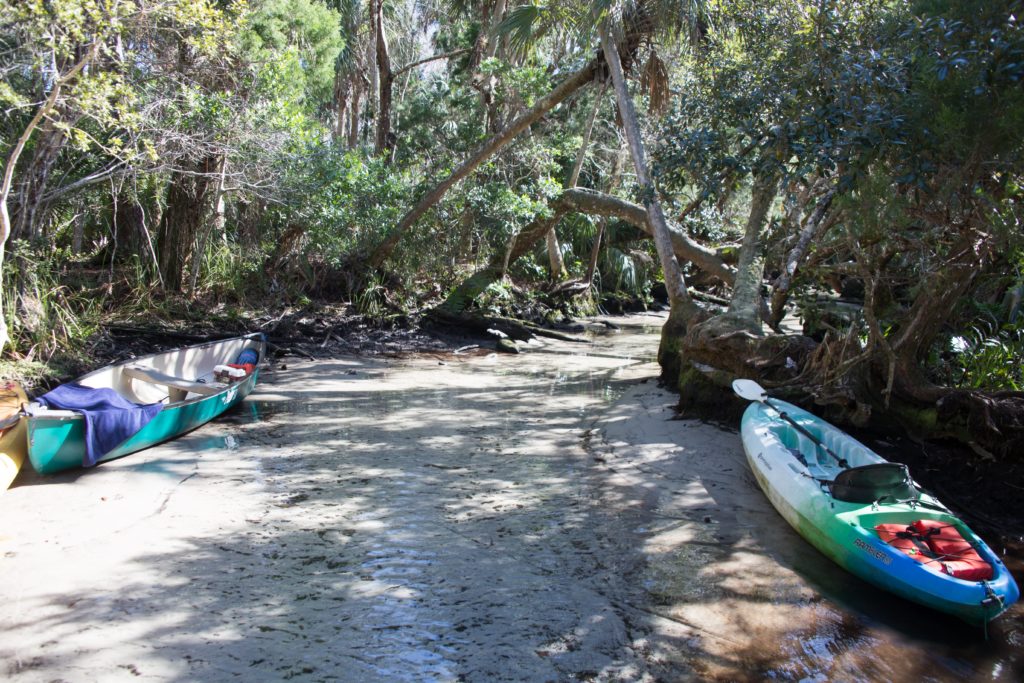
If you leave it at the entrance, be sure to secure your canoe or kayak well so it does not float away.
There is deep, stinky mud in this area. Some areas are sandy, but muddy areas will not support your weight. If you step on the wrong spot, you may sink into deep, stinky mud.
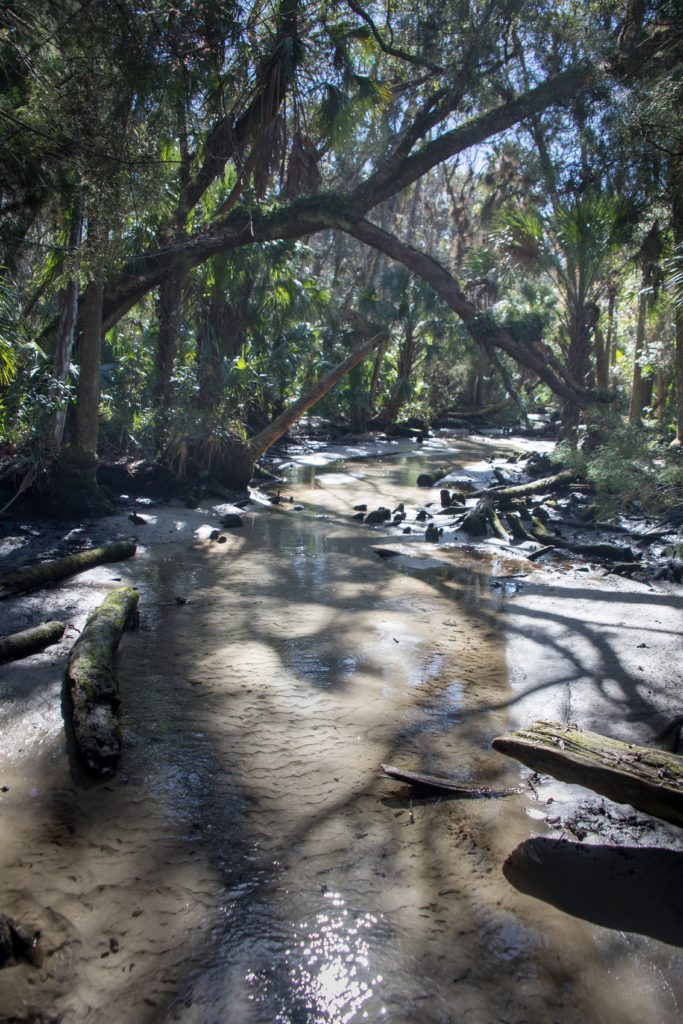
There may be sharp items, broken glass, fish hooks or other possible hazards in the area, good footwear is advised. Flip flops are not recommended because they tend to get sucked into the mud.
The entrance is fairly obvious.
- Continue up Baird Creek for another 1/2 mile.
- Make noise as you pass through Baird Creek to avoid surprising any possible alligators.
- You’ll pass through a series of alternating shallow areas and deep-water basins. Some areas are very narrow with tall grass and forest. There are logs, submerged limbs and overhanging trees throughout the creek.
- Watch out for alligators, and make noise as you go.
- At the end of Baird Creek you’ll pass through a large, deep basin. This is Blue Spring. You can usually see a spring boil on the water surface. It is not recommended to swim here.
- Shortly after Blue Spring, the creek turns into a smaller, narrower section. At the end you’ll see the shallow spring run to the Crack spring run.
- Securely tie your kayak or canoe and/or walk the remaining distance.
- The Crack is at the end of the spring run. You’ll see a broad clearing, a swimming hole, and a rope swing hung from a tree.
Baird Creek is exceptionally shallow, especially at low tide. There are many logs and zero-depth sandbars. Even kayaks and canoes struggle in many areas and must be portaged.
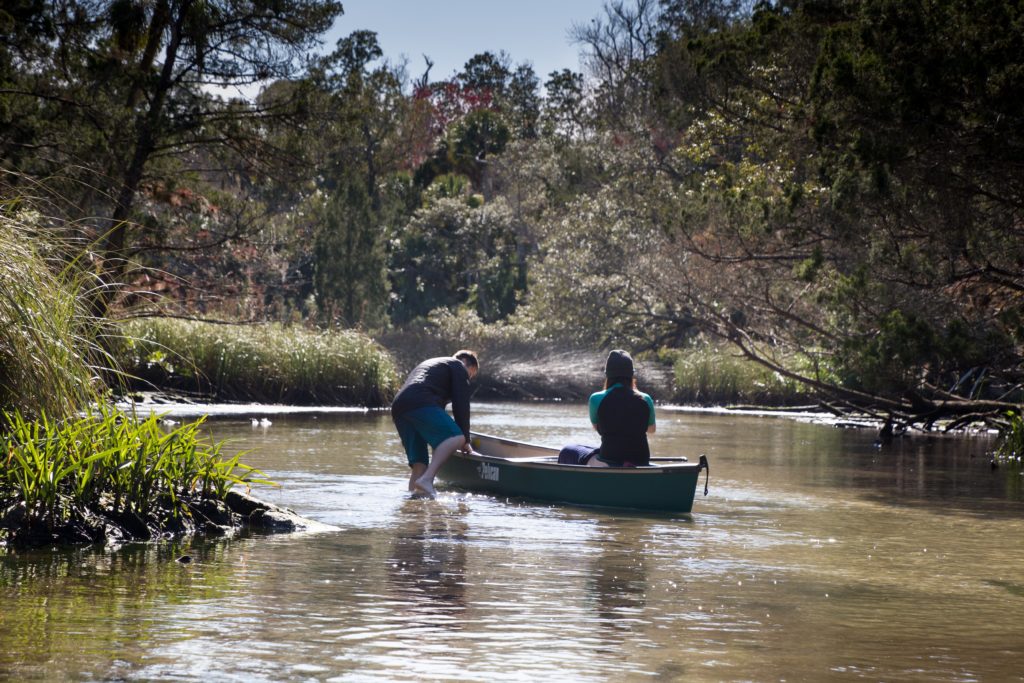
Do not try to navigate Baird Creek in any type of motor boat, or with a deep-draft vessel.
Propellers will damage the fragile river bottom and banks. It may cause motor damage when sediment is sucked into the motor’s cooling water intake.
In shallow areas of Baird Creek, paddlers should try to stay in deeper areas and avoid disturbing the river bottom because it harms the health of the river.
Health of the Springs
The Chassahowitzka River has been recognized as an Outstanding Florida Waterway. Part of the river lies in the Chassahowitzka National Wildlife Refuge.
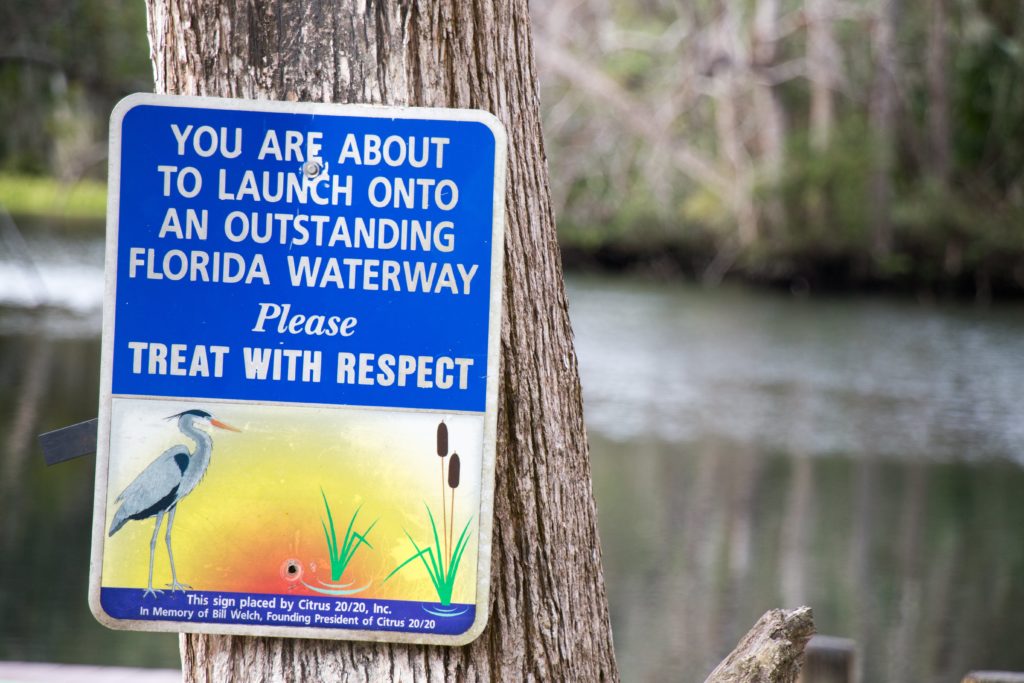
The refuge also contains other springs like Eagle’s Nest Spring, which is popular with hard-core cave divers.
Other nearby springs include the beautiful Weeki Wachee Springs and Three Sisters Spring, which are also relatively nearby.
The Chassahowitzka River is endangered by many threats, but it is one of the few remaining rivers in Florida which are undeveloped and relatively healthy.
Large expanses of the Chassahowitzka River are undeveloped, but many sections have been bulldozed, dredged and altered from their natural state by real estate developments.
The aquifer and springs in the Chassahowitzka River have been damaged by pollution from a variety of sources, including industrial agriculture and failing residential septic tanks.
The Chassahowitzka River is also vulnerable to physical damage caused by visitor overuse and abuse, salt water contamination and sea level rise.
In recent years the Chassahowitzka River was inaccessible due to runaway algae growth, fueled by nutrient pollution.
The Southwest Florida Water Management District (SWFWMD) performed extensive and expensive clean-up operations to restore the river from pollution damage.
Despite major efforts, the SWFWMD website notes that the springs’ health is poor.
It is a sad reminder that Florida’s springs, drinking water and aquifer are in severe danger from many threats.
It is always more expensive, and harder to “fix” a polluted environment than it is to keep the environment clean to begin with.
Over-pumping, industrial agriculture, fertilizer and sewage from leaking septic tanks are mostly responsible for Florida’s water pollution and aquifer damage.
Tide and Fishing Report
Visitors should check the local tide conditions. The local tide conditions will impact the water depth and water flow of the river.
This report also includes a rough fishing report and condition overview.
Protecting the River
Boaters, swimmers and paddlers should be careful not to disturb the bottom because it damages the river in many ways.
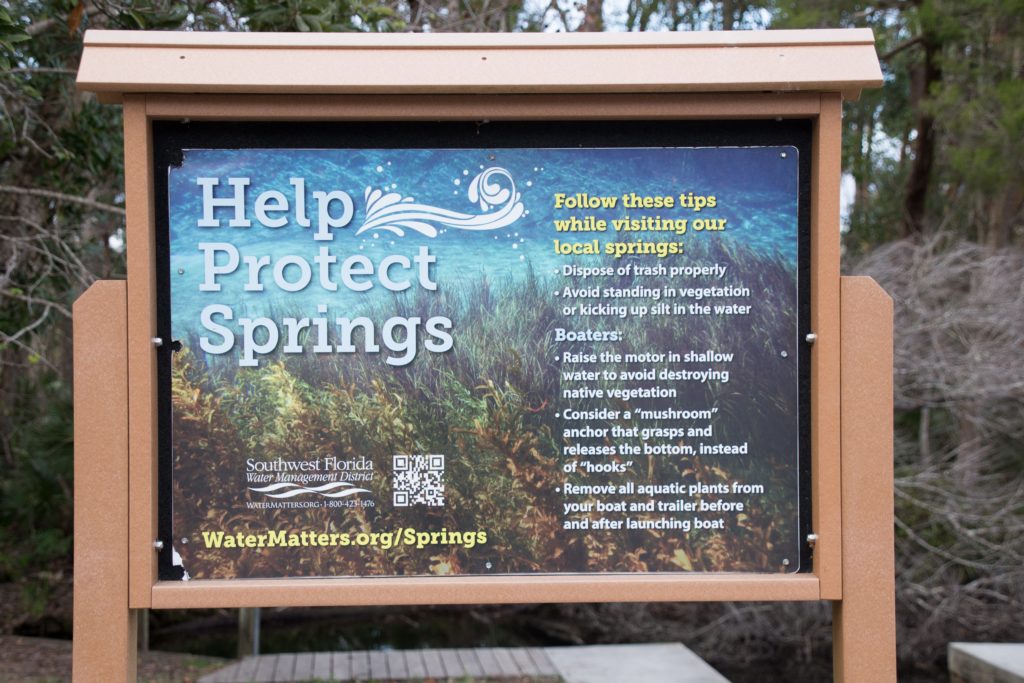
The Chassahowitzka River is very shallow. It is less than four feet deep in many areas. The river bottom is sensitive.
Damage from boats, paddles and human feet damage fragile underwater grass, which is important for the river’s health, fish populations, erosion prevention, and for feeding manatees.
Disturbances on the river bottom also disrupt the water clarity and may cause sediment to spread throughout the river, which can cause other problems.
All visitors should be careful not to disturb the river banks or bottom.
All visitors must also be extremely aware and careful not to harm or disturb manatees, who need the river and springs for survival.
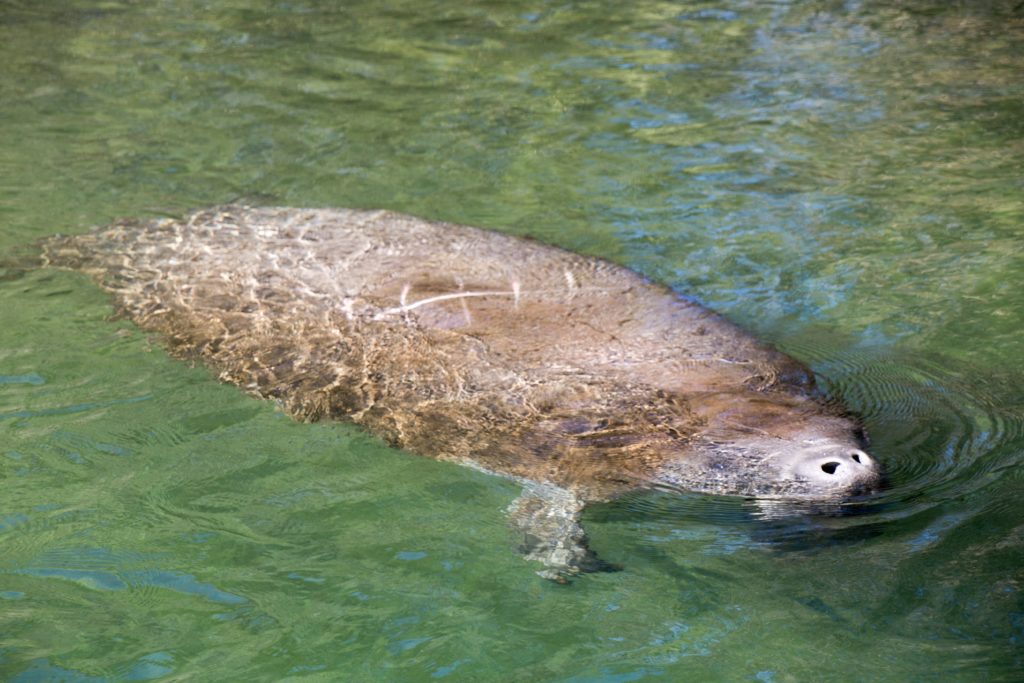
Please do not leave litter or trash anywhere on the river. If you see trash from other people, please consider picking it up and leaving the river cleaner than you found it.
Boaters should be careful to:
- Avoid gasoline, fuel or chemical spills
- Avoid running aground
- Maintain slow speeds
- Do not allow your propeller wash to disturb the river bottom
- Avoid allowing your wake to disturb the fragile shorelines
- Watch for numerous shallow areas and submerged obstructions
Boat Traffic
Paddlers are often advised to stay to the sides of the Chassahowitzka River to allow boat traffic to use the center, which is slightly deeper.
Some irresponsible boaters travel at relatively high speeds, so visitors should take care and remain aware of their surroundings.
